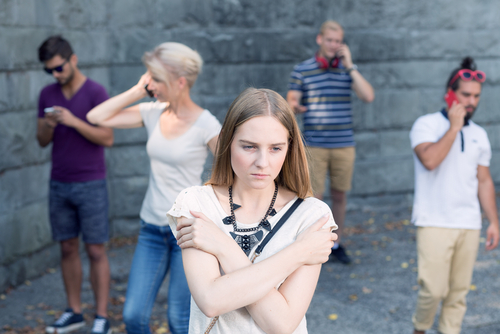The American Psychiatric Association (APA) explains that, “anxiety refers to anticipation of a future concern and is more associated with muscle tension and avoidance behavior.” Anxiety disorders involve excessive feelings of nervousness, anxiousness, fear and anxiety. Social anxiety disorder (SAD), also known as social phobia, is listed in the Diagnostic and Statistical Manual of Mental Disorders, Fifth Edition (DSM-5) as a chronic mental health condition. According to the National Institute of Mental Health (NIH), social anxiety disorder “is characterized by persistent fear of one or more social or performance situations in which the person is exposed to unfamiliar people or to possible scrutiny by others.” An individual with SAD will avoid social situations due to a fear of being negatively evaluated (e.g., embarrassed or judged) by other people. Individuals with social anxiety disorder will experience a stronger and more intense sense of anxiety surrounding uncomfortable social situations than that of an individual without SAD.
Signs and Symptoms
Every individual is unique and will have his or her own set of challenges in regards to social anxiety. There are certain common signs and symptoms an individual struggling with SAD could exhibit. These include the following examples, provided by Healthline:
- Muscle tension
- Agitation
- Excessive worry and or fear
- Sweating
- Irritability
- Shaking
- Poor eye contact with others
- Low self-esteem/ low self-worth
- Sadness
- Crying
- Refusing to attend school and or social engagements
- Anger
In addition to the above, an individual with social anxiety disorder may have frequent self-deprecating thoughts and thoughts of inadequacy. In order to secure the most effective treatment, it is essential to obtain a proper diagnosis from a qualified mental health professional.
Clinical Diagnostic Process
According to the Mayo Clinic, a social anxiety disorder diagnosis will be determined after conducting a thorough physical exam, a psychiatric evaluation, and will be informed by the diagnostic criteria provided in the DSM-5. It is also common for an evaluating clinician to request an individual to complete self-report questionnaires regarding one’s symptoms of social anxiety, as well as review a list of situations to see if they elicit anxiety. The diagnostic criteria for social anxiety disorder, according to the DSM-5, provided by the Mayo Clinic, include:
- Persistent, intense fear or anxiety about specific social situations because you believe you may be judged, embarrassed or humiliated
- Avoidance of anxiety-producing social situations or enduring them with intense fear or anxiety
- Excessive anxiety that’s out of proportion to the situation
- Anxiety or distress that interferes with your daily living
- Fear or anxiety that is not better explained by a medical condition, medication or substance abuse
The exact scientific cause for developing social anxiety disorder remains unknown. Research has shown that it is likely due to a combination of contributing factors such as psychological, environmental, genetic, and developmental factors.
Disclaimer:
The information above is provided for the use of informational purposes only. The above content is not to be substituted for professional advice, diagnosis, or treatment, as in no way is it intended as an attempt to practice medicine, give specific medical advice, including, without limitation, advice concerning the topic of mental health. As such, please do not use any material provided above as a means to disregard professional advice or delay seeking treatment.




